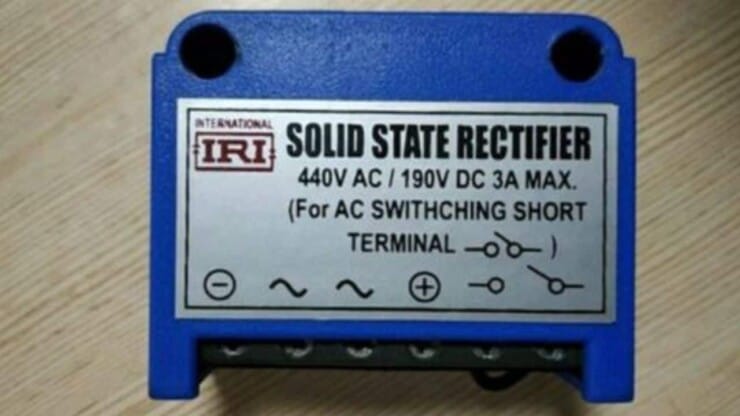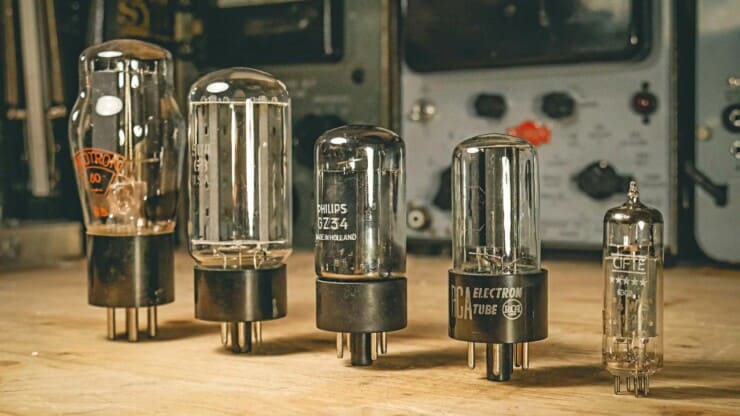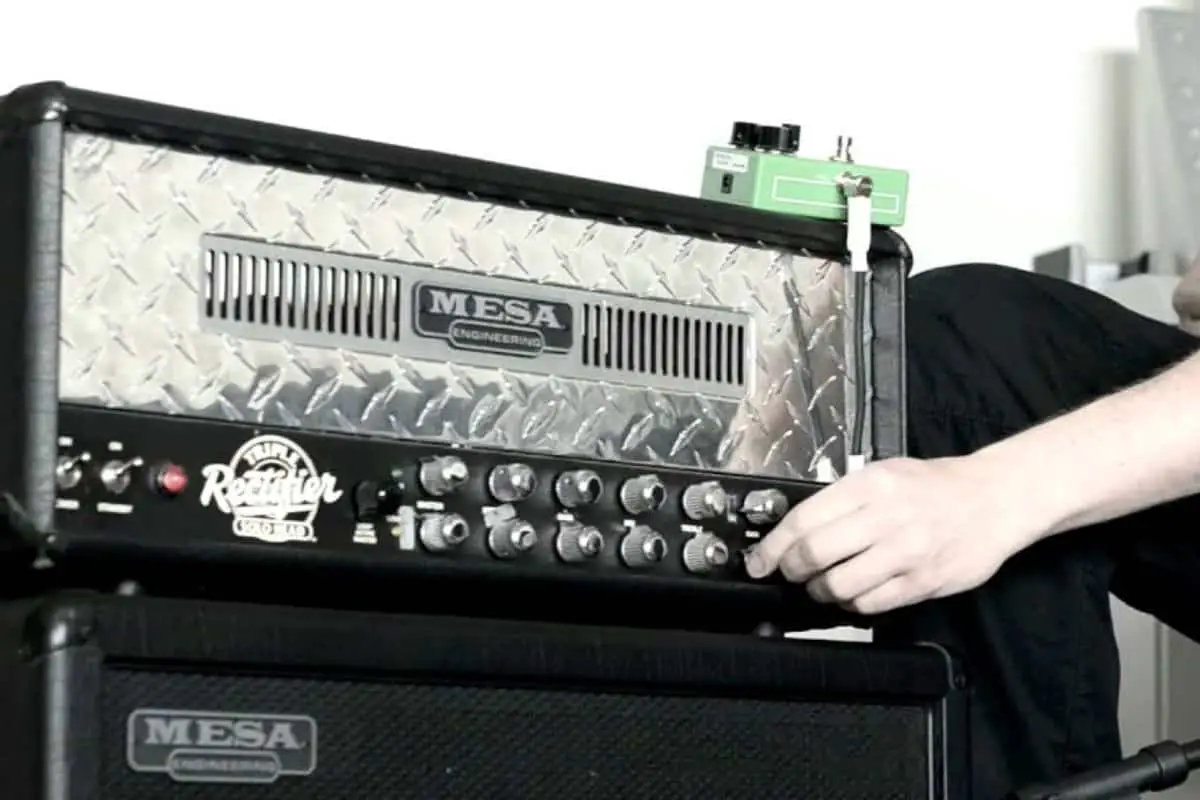Are you setting up your guitar rig, but you’re unsure about the role of a rectifier because you don’t know what it is? Then today is your lucky day, and you’ve landed on the right page.
Rectifier in a guitar amp is essentially the component responsible for converting AC power into DC power. This conversion is necessary as the rest of the amp’s circuitry needs DC voltage for operating.
In this article, you’ll get to know all about rectifiers, what is a rectifier in a guitar amp, what does a rectifier do in a guitar amp, the difference between tube rectifiers and solid-state rectifiers, and more. Stick around to find out all the answers that you’re looking for.
What is a rectifier in a guitar amp?
In simplest terms, a guitar amp rectifier is what converts AC power into DC power. The power enters an amp from the wall plug-in AC voltage, it’ll work its way through the amp’s power transformer and ultimately to the rectifier. Here, it will get converted to DC voltage. This is important as the rest of the amp’s circuitry requires DC voltage for operating.
To be a bit more specific, a rectifier is just a diode (be it a tube or solid-state). A diode is a small valve or a getaway that forces electricity to flow in a single direction. In guitar amps, this process will typically involve the voltage getting bumped up to the amount demanded by other tubes in the circuit. For instance, in the United States, power comes from the wall and into the guitar amp at 120VAC. The power transformer then bumps the power up to around 330VAC.
Finally, the rectifier then converts the power from AC to DC, often bumping the voltage to or above 400VDC. The rectifier itself isn’t actually in the amp’s signal chain. This means that your guitar’s signal won’t pass through the rectifier at any point.
Tube rectifiers
As mentioned above, a rectifier is just a diode. The tube diode was the first diode to have ever been invented. It was the very first vacuum tube to have ever been invented as well. It’s true that tube rectifiers and solid-state rectifiers both perform the exact same task. However, it’s also true that the amount of DC that these devices can make and the speed at which they do it are very different.
This is the biggest reason why so many guitarists live by the idea that tube rectifiers are the superior choice. Tube rectifiers are generally slower at converting AC to DC. When a guitar amp is being pushed and the guitarist is hitting big chords, a lot will be demanded from the rectified current. The tube rectifier struggles to keep up with the demand. When this happens, the tube rectifier will experience a voltage drop for a couple of milliseconds as it catches up. To the normal ears, this is what is referred to as “sag”.
Sag is what gives the players the classic compression, which defines the traditional tube amp sound. When sag is felt and heard, the guitarists often start using words like “spongy” and “bloom” for describing the sound. Many amps have become popular from this sound, such as the Marshall JTM-45, Fender’s Deluxe Reverb, and Vox AC30.
Sag isn’t just determined by whether the amp features a tube rectifier or solid-state rectifier. Different tube rectified amps have different voltage requirements, and they used different values of tube rectifiers. The 5Y3 rectifier tube included in a Fender Tweed Deluxe is a rather small rectifier tube. It is capable of producing less DC voltage and exhibits more sag/compression. Heavy-duty tube rectifiers include the 5U4G and GZ34, and they have a quicker response and supply more voltage. This means that they’ll exhibit a tighter sound with comparatively less sag.
Solid-state rectifiers
Solid-state technology only came about in the 1950s. In the case of rectifiers, this was in the form of a small silicon diode. These quickly ended up becoming less expensive than tube rectifiers, and they were used more often. They also don’t have any internal compression and work more perfectly in the world of engineering. Solid-state rectifiers have less, if any, voltage drop, and they’re able to deliver more current rapidly. This is why they’re used in higher-wattage amps, where tube rectifiers are rarely found in amps over 40W.

Sonically, this will yield a tighter sound with a lot less sag. A solid low-end with a lot of headroom is typical (as it’s great for metal players and fat pickers). The drawback here is that with little to no sag, most guitarists miss the vintage compression and spongy playing feel. Power tubes and preamp tubes exhibit some sag of their own when hit hard enough. Even solid-state rectified amps containing power and preamp tubes have some sag if pushed very hard. But it’ll typically not be to the extent of tube-rectified amplifiers.
Here again, there are many popular amps designed to be used as a decent solid-state rectifier. Some of the most popular ones include Carr Rambler, Fender Twin Reverb, and more. Mesa Boogie’s ever-revered Dual Rectifier allows the guitarists to switch between tube and solid-state rectifiers seamlessly.
The historic context of what does a rectifier do in a guitar amp
The history of tube rectifiers
At one time, all the rectifiers used to be tube rectifiers. Tube rectifiers used to be found in just about every vacuum tube-based product. In fact, it was used in all electronics, radios, TVs, transmitters, amps, etc. Tube amps used to be far from perfect and were slightly limited in two important ways –
They have an internal impedance that causes sag under high current draw (it’ll be like when an amp gets cranked up, and you hit a note). This is important to amps, as some guitarists desire the sag of a tube rectifier. The bottom end will be looser while the tone more singing when it is cranked up.
Tube rectifiers are fairly limited in how much current they’re able to deliver. This is why you will rarely find guitar amps with tube rectifiers over 40 watts. This will also limit how much filtering can be done in the power supply. There were many older amps that have very light filtering, which could potentially lead to problems.
Tube rectifiers feature voltage drop across them, which affects the sound.
Solid-state rectifiers
Later on, solid-state rectifiers and diodes (the part which makes up the rectifier) came along. At the start, solid-state rectifiers were expensive. However, they quickly became a lot less expensive compared to tubes. They feature little to no sag and can offer lots of current without any voltage drop. Additionally, they will be much more reliable. All that results in a firmer sound with better reliability.
What does a rectifier tube do in a guitar amp?
To put it in simple words, a rectifier is essentially a component or network of components in a tube amplifier. It will convert the positive and negative lines of AC current from the amplifier’s power transformer into a single line of DC current. It’ll enable the other signal-amplifier tubes to do their own thing.
During the AC-to-DC conversion, a rectifier will usually increase the resulting DC voltage level. In fact, the voltage levels will be increased twice on the way to the big output tubes. For instance, take Fender Deluxe Reverb as an example. The AC will come into the amp from the wall socket at around 120V. It’ll then be ramped up by the PT to almost 330V AC. Ultimately, it gets converted by the rectifier to more than 400V DC to feed the 6V6GT output tubes.
A rectifier will convert AC to DC, as simple as that. It isn’t in the signal chain, which means the portion of the amp’s circuit that carries the guitar signal doesn’t pass through it at any time. Although tube rectifiers are generally fussed over the most, most tube-based amps have a rectifier of one type or another.
Rectifiers come in two different formats – tube and solid-state. In today’s retro-inspired world of misinformation and sonic myth where any guitar gear possessing a glowing glass bottle is assumed to be better than the gear without it, it’ll be important to understand that solid-state rectifiers aren’t implicitly inferior to tube rectifiers. In fact, they are totally different.

It’ll be worth noting that an otherwise all-tube amp that contains a solid-state rectifier can legitimately be referred to as an all-tube amp. Among rectifiers that are tube-based exclusively, there are many types that’ll offer different performance characteristics depending on the needs of different amplifier designs. Solid-state rectifiers (which, today, mostly comprise silicon diodes) seem to vary slightly. However, this is generally in accordance to how many diodes are needed, depending on the size and power demands of the amp.
It’ll be a feel thing
Coming back to the above statement, a rectifier converts AC to DC, it is as simple as that. It isn’t in the signal chain. It’ll be easy to take from it the conclusion that the type of rectifier featured in any amp doesn’t affect its sound. However, it isn’t strictly like that. Different rectifier tube amps and different rectifier designs could have a significant impact on the amp’s playing feel. Every guitarist knows that “feel” tends to have a more notable impact on their impression of tone.
Preamp and output tubes sound and perform differently when they’re fed different voltages. A rectifier will convert your PT’s 330V AC to 400V DC. This results in the amp sounding slightly different than it’ll do with a rectifier that converts it to 350V DC. Apart from considerations of efficiency, two other factors will compound its effects on your sound –
Speed of AC TO DC conversion
The speed at which it will accomplish the AC-to-DC conversion will be felt distinctly at either extreme. It’ll be either as a fast, tight, responsible, and articulate performance in the amp with an efficient and swift rectifier or as a soft, forgiving feel in the amp with slower rectifiers. Neither of them is inherently good or bad, and so will be the case with many things tone-related. It’ll depend entirely on what you are looking for.
Recovery time of rectifier
The quickness at which the rectifier recovers from heavy demands after its conversion duties. For instance, when you are hitting the guitar hard for aggressive passages with the guitar amp turned up loud. This will contribute to a feeling of compression while adding the “bloom” to the notes.
These factors will combine to affect the impression of attack, dynamics, compression, and touch-sensitivity that a tube amp gives you. As a result, this is where players notice how their rectifiers are performing and if they’re consciously aware of it.
Does it mean that amps with solid-state rectifiers do not sag and compress? No, this is not the case at all. This is due to the output and preamp tubes themselves also sag. Moreover, they bloom and compress in response to the workload when playing hard and loud. They’re more in certain designs and less in others, and it contributes to the “feel” aspect in any given amp.
Best rectifiers in the market: Is there a winner?
None of it is intended to imply that one type of rectifier is significantly better than the other. The actual answer is that they’re just different. In fact, the “better or worse” argument only comes into play depending on what genre of music you’re playing. Often, you will be satisfied with amps that carry either type of rectifier. For many genres, the highly acclaimed tube rectifier will be the poor relation.
Over the years, most guitarists open that you’ll need a tube rectifier to get a good and clean tone. However, the Fender Twin Reverb is often lauded as the best-sounding clean amp produced, but it has a solid-state rectifier. Similarly, the Carr Rambler combo uses a solid-state rectifier too, and it’s cited as a great-sounding clean machine for clubs.
At the other end of the spectrum will be that it’s often the shred and metal players who specifically go and look for qualities that solid-state rectification offers. It is found in a fast, tight low-end, detailed response, and a lot of punching power. It’ll be worth noting that it’s stricter design-wise to offer tube rectification in amps of 100W or more. However, this has been done before, often using multiple rectifier tubes together, such as in the Mesa Rectifier series.
Vintage and modern classics that carry solid-state rectification include names like the Marshall Plexi. It also involves the assorted later models that have evolved from the platform, 50W and 100W Hiwatts, Soldano’s SLO, Friedman’s BE-100, Bogner’s Ecstasy, and Mesa/Boogie Mark Series amps among others that don’t suffer from this form of AC-to-DC conversion.
Despite the seminal Twin Reverb reference, tube rectifiers are generally found in many other classic twang ‘n’ roll amps like Fender’s Super Reverb, Deluxe Reverb, and more. They’re even found in amps favored by guitarists of vintage-leaning rock and roll, raw roots rock, blues, and other styles.
With that said, a lot of heavier rock has been logged on great tube rectified amps. Some include choices like the Fender’s tweed Bassman and tweed Deluxe, the Vox AC30, the Marshall JTM45 head and Bluesbreaker combo, and more. It’ll be almost pointless to try and pin the components down to a single genre. The maximum it’ll go is the heavy rock and metal extremes, which lean towards solid-state in most cases.
Be aware that you aren’t shopping for your next guitar amp according to the type of rectifier it has. You’ll more likely to find the right amp for you and your music just by plugging into all the options. Explore the options in your price range and give them all a thorough test drive.
Regardless of what they’re using for AC-to-DC power conversion, let your fingers and ears decide what is right for you. Knowing a bit more about what is a rectifier in a guitar amp and what it does will help you. You’ll be better informed and be able to avoid any promotional misdirection and end up buying the wrong amp.
Different tube types in solid-state rectifiers
Although there isn’t much to see in solid-state rectifiers, the types of tube rectifiers in amp designs is important. It will give you a better understanding of the relative softness or hardness of its playing feel. There are some other factors that contribute to it too.
The varying efficiencies and recovery times of different types of tube rectifiers hint at the compression and sag you’ll get from the amp they’re loaded into. Running in order of the softness to the firmness, some common rectifier tube types will be –
- 5Y3: They’re commonly found in American amps of 20W or less like the Princeton, the tweed Deluxe and its derivatives
- EZ81: Here’s a nine-pin British rectifier tube that’ll look like an EL84 output tube at the first glance. These are usually present in the original Vox AC15s and sub-20W British amps and their derivatives.
- 5V4: These are housed in a smaller glass bottle than most other eight-pin rectifiers. The 5V4 is slightly firmer than the 5R4 and 5Y3. These days, they’re most commonly found in pairs as a replacement option for the single firmer GZ34. They come standard in Matchless DC30 for guitarists who want a soft playing feel and a bit more sag.
- 5R4: This one is a large-bottled rectifier tube (which shouldn’t be confused with the 5AR4 mentioned in the previous point). These are rarely present in modern designs, but they offer mid-level sag to vintage amps.
- 5U4G: These are the relatively firm rectifier tubes often found in mid-sized Fender Silverface and Blackface amps.
- GZ34: Similar, if not identical, the British GZ34 was a key component of the original Vox AC30 of the early ‘60s while the American 5AR4 was standard in many larger Fender amps. Both of them are among the firmest and most efficient tube rectifiers found in guitar amps. However, they offer a bit more sag than solid-state diodes when they’re pushed hard.
In certain cases, one rectifier tube type can be substituted for another one to tweak the feel of the amp. However, you shouldn’t do this without consulting the amp’s manufacturer or a qualified technician first. Mismatching rectifier tubes, can, in most cases, lead to major failure and dangerous malfunctions. This is an even bigger possibility when it results in applying higher voltage levels to other components of your amp.
Conclusion
Thank you for reading. Hopefully, now you know a lot more about rectifiers, what is a rectifier in a guitar amp, what does a rectifier do in a guitar amp, the difference between tube rectifiers and solid-state rectifiers, and more.
Guitar amp rectifiers are essentially the amp components responsible for converting the AC power in the amp to DC power. This conversion is a necessity as the rest of the guitar amp’s circuitry requires DC voltage for operating. The rectifier will convert the positive and negative lines of the AC current from the amp’s power transformer into a single line of DC current. Ultimately, this allows the other amplifier components to do their own thing effectively.
Image Credit:
Images: Reverb, Trade India



